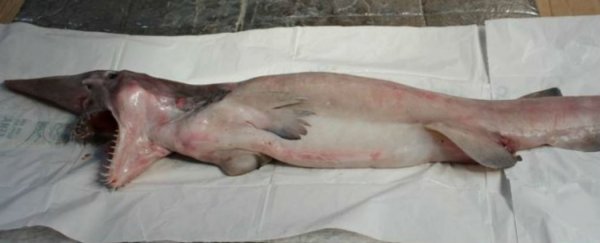Just weeks after a bizarre frilled shark was found on Australia's southeast coast, a rare and incredible-looking goblin shark has been caught off the coast of New South Wales, after being caught up in a fisherman's net.
As Kate Smith from Merimbula News reports, it was snared by local fisherman, Lochlainn Kelly, in Green Cape, which is just south of the town of Eden, on the NSW south coast. "We just winched up the wire and brought the net on and the shark was in the net," Kelly said. "I wasn't [freaked out], if anything I was pretty excited. I've seen photos of them before but I've never seen one before."
Upon bringing it to Wharf Aquarium curator Michael McMaster and marine biologist Alan Scrymgeour from the Sapphire Coast Marine Discovery Centre, Kelly had this incredible specimen identified as a goblin shark (Mitsukurina owstoni) - a species that usually lurks at depths of around 1,200 metres below the surface, well out of the way of any fisherman's tools.
The pair estimate that the shark was only young - about two or three years old - based on its length of just over a metre. It's thought that goblin sharks don't tend to grow to over 4 metres in length, and the maximum recorded weight for an individual is 210 kg, but in 2000, a 6.2-metre-long female was captured, which means we're really not sure how big these finned enigmas are capable of growing.
Scrymgeour told Merimbula News that the species has hit an "evolutionary dead end", as the only member of its genus, which stopped evolving about 70 million years ago.
It's not clear why the species has remained so incredibly unchanged throughout the millennia, but it could simply be that it's already so good at surviving, there's a lack of selective pressure to drive evolutionary change. That wonderful 'nasal paddle' is how it detects its prey - it can pick up on small electrical fields given off by crustaceans, octopuses and squid, and when it finds them, it will extend its jaw almost to the end of its snout, and chomp them down, using over 100 rows of pointy teeth.
"Their teeth are often found in underwater electrical cables," McMaster told Merimbula News. "A lot of fishermen have been saying that the currents are very different this year," he added, which he thinks could be the reason it was caught much closer to the surface than it would normally go.
While it's super-sad that this shark had to die in order for us to see it, I always appreciate the reminder of how truly alien the deep sea is. Like this ridiculous megamouth shark, found off the coast of the Philippines last month. And we don't even know the half of what's lurking down there.
Head to Kate Smith's report at Merimbula News to see more images of the newly discovered goblin shark.
Source: Merimbula News
